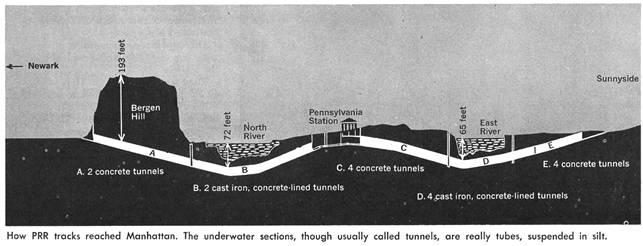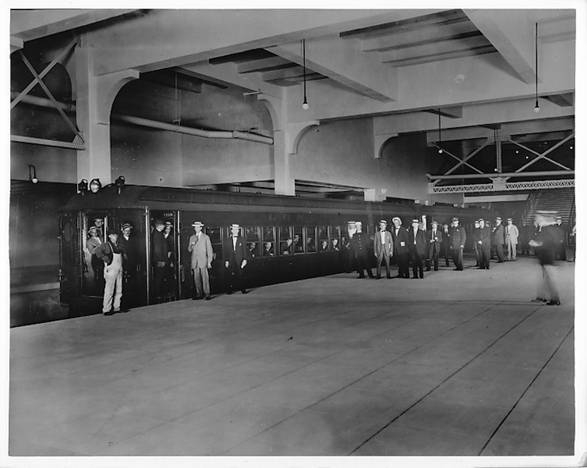The Change
For decades, several interstate railroads (other than the New York Central) had offered "New York service" by connecting to ferry terminals in New Jersey. They did not dare attempt to actually cross the Hudson. The financing needed for a railroad to move scores of passenger trains daily between Manhattan and the mainland over or under the Hudson River would be astronomical, and a bridge or tunnel of the requisite length would be without precedent.
Exchange Street Ferry Terminal Wikipedia
And then the Hudson and Manhattan demonstrated that technology finally existed to build a safe, workable rail tunnel under the Hudson. The Pennsylvania Railroad, long jealous of its arch-rival New York Central, was one of the wealthiest railroads in the country; it decided to undertake such a project. New York passengers on the Pennsy's seats and ride end-to-end between Manhattan and say, Chicago, "name" trains finally would be able to sit in their luxurious parlor-car Philadelphia, or Washington D.C., without even hearing the word "ferry" mentioned once.

PCPOST HudsonRiverTubes Diagram.png
Wikimedia Commons
That was the concept of the project, but there was more to making it real. There would be collateral impacts, for the Pennsylvania would need storage and service facilities east of the new station. That meant constructing the first tunnels under the East River, to extend the tracks through the new station into Queens. It also meant the Pennsy would acquire control of the Long Island, and expand the latter's property in Queens into the world's largest passenger rail yard. There also would be tunnels for the LIRR's use, and dedicated LIRR tracks at the new Penn Station. Long Island riders would finally get to say "goodbye" to the East River ferries.
On September 8, 1910, when a Long Island train became the first train to ever use Pennsylvania Station, people all over the Island celebrated. On that first day, many Long Islanders rode the trains through the tunnels to Manhattan and back, just to be able to brag about it afterwards.

The first passengers to arrive in Pennsylvania Station
untappedcities.com
Others went down to local stations all over the LIRR and waited, which raises an interesting point. Did these people realize what they were waiting for?
Only electric-powered trains were allowed in the new tunnels, but only part of the LIRR used such trains. Most of the railroad relied on steam locomotives, which meant that people who waited at, say, Hicksville or Northport would be greeting steam trains, which had not passed through the tunnels. People coming back to those stations from Manhattan had to change trains at Jamaica. (Who could have guessed?).
So, the people who celebrated in the photograph below, with their flags and perhaps their picnic baskets, were at the station to welcome neighbors and friends who had ridden through the tunnel, just not on the trains that brought them home.

People waiting in Northport to greet passengers who rode through the new tunnels on their
first day of service. This train would have passed through Hicksville en route to Northport.
Steel Rails to the Sunrise
***

